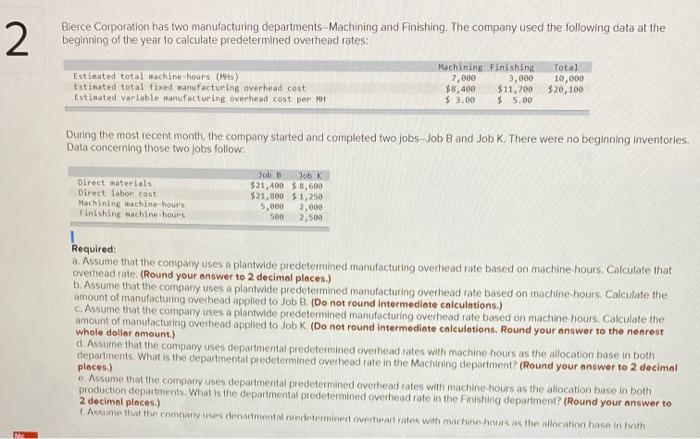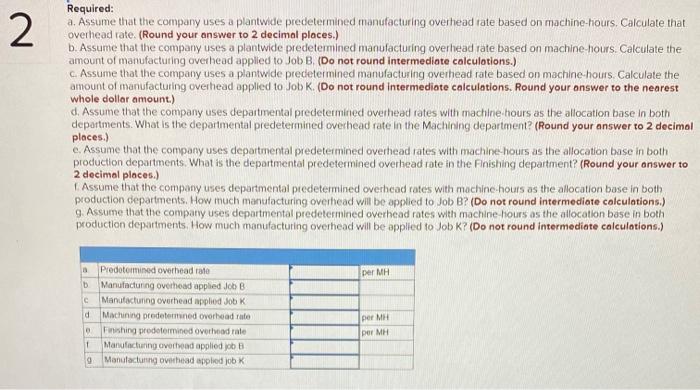Please answer all parts. If answered correctly, I will provide positive feedback! thanks

2 Bierce Corporation has two manufacturing departments Machining and Finishing. The company used the following data at the beginning of the year to calculate predetermined overhead rates: Estimated total machine hours (PH) Estimated total fixed manufacturing overhead cost Istinated variable manufacturing overhead cost per Machining Finishing 7,000 3,000 $8,400 $11,700 $ 3.00 $5.00 Total 10,000 $20,100 During the most recent month, the company started and completed two jobs - Job Band Job K. There were no beginning inventories. Data concerning those two jobs follow Direct materials Direct labor cost Machining machine hours Finishing machine hours Job Job $21,400 $3,600 $21,800 $1,250 5,000 2.000 500 2,500 Required: a. Assume that the company uses a plantwide predetermined manufacturing overhead rate based on machine hours. Calculate that overhead rate (Round your answer to 2 decimal places.) b. Assume that the company uses a plantwide predetermined manufacturing overhead rate based on machine hours. Calculate the amount of manufacturing overhead applied to Job B. (Do not round Intermediate calculations.) c. Assume that the company uses a plantwide predetermined manufacturing overhead rate based on machine hours. Calculate the amount of manufacturing overhead applied to Job K. (Do not round intermediate calculations. Round your answer to the nearest whole dollar amount.) d. Assume that the company uses departmental predetermined overhead rates with machine hours as the allocation base in both departments. What is the departmental predetermined overhead rate in the Machining department? (Round your answer to 2 decimal places.) e Assume that the company uses departmental predetermined overhead rates with machine hours as the allocation base in both production departments. What is the departmental predetermined overhead rate in the Finishing department? (Round your answer to 2 decimal places.) Acum vit the comarcas dentment determined whead es with eachine hours at the allocation base in both 2 Required: a. Assume that the company uses a plantwide predetermined manufacturing overhead tate based on machine-hours. Calculate that overhead rate. (Round your answer to 2 decimal places.) b. Assume that the company uses a plantwide predetermined manufacturing overhead rate based on machine hours. Calculate the amount of manufacturing overhead applied to Job B. (Do not round intermediate calculations.) c Assume that the company uses a plantwide predetermined manufacturing overhead rate based on machine hours Calculate the amount of manufacturing overhead applied to Job K. (Do not round intermediate calculations. Round your answer to the nearest whole dollar amount.) d. Assume that the company uses departimental predetermined overhead rates with machine hours as the allocation base in both departments. What is the departmental predetermined overhead rate in the Machining department? (Round your answer to 2 decimal places.) e. Assume that the company uses departmental predetermined overhead tates with machine hours as the allocation base in both production departments. What is the departmental predetermined overhead rote in the Finishing department? (Round your answer to 2 decimal places.) Assume that the company uses departmental predetermined overhead rates with machine hours as the allocation base in both production departments. How much manufacturing overhead will be applied to Job B? (Do not round intermediate calculations.) g. Assume that the company uses departmental predetermined overhead rates with machine hours as the allocation base in both production departments. How much manufacturing overhead will be applied to Job K? (Do not round intermediate calculations.) per MH C Predatormined overhead rate D Manufacturing overhead applied Job B Manufacturing overhead applied Job d Machining predetermined overhead role 0 Finishing predetermined overhead rate 1 Manufacturing overhead applied job 9 Manufacturing overhead applied job per MHI per MH









